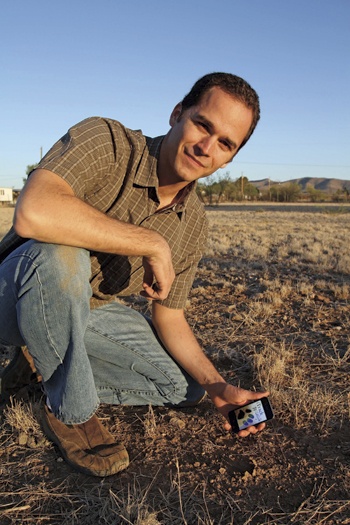Read any best-sellers lately? Prefer historical nonfiction or maybe the latest titles in science fiction? Like many people, Jonah Evans of Alpine in far West Texas loves a spine-tingling mystery. But his favorite page-turners can’t be found on a bookshelf or in a library. Instead, Evans—who created iTrack Wildlife, a digital field guide made exclusively for iPhones and iPads that contains track information for 65 North American mammals—sleuths the oft-ignored footprints of elusive animals.
“If you’re aware of tracks, then you can read stories of what’s happening around you,” says the 33-year-old Evans, an expert tracker who’s employed as a wildlife diversity biologist with the Texas Parks and Wildlife Department. “Tracks can help you know who’s eating who, which is the crux of the dramas happening in an open field or on a muddy riverbank. Mice and rats feed on grass seeds. The scat of gray foxes and coyotes contain their bones. Owl pellets may, too. So if you learn to read animal tracks, you learn their stories.”
For Evans, even a seemingly mundane stroll down his dirt driveway can turn up fascinating tales of after-dark trysts and midnight mayhem. “In the morning, when I leave for work and walk outside to my pickup, I read tracks left in our front yard by javelinas, deer, raccoons and striped skunks,” Evans says. “Then after I get out of my truck at my office, I read more tracks left by gray foxes, White-winged Doves and domestic cats.”
Tracking, said to be both an art and a science, blends storytelling with acute observation. “Animals are shy and hide from us,” explains Evans, who always totes his digital camera so he can document what he finds. “But an experienced tracker can take a walk and find signs, like tufts of hair, digs and burrows, or skulls and bones. A good tracker can even sometimes tell if the animal stopped to turn and look behind it.”
Deciphering a track used to be tough. Not anymore, thanks to Evans. Last fall, he released iTrack Wildlife, an application that features more than 675 photos of animals, tracks and scat along with front and hind feet track drawings, gait information and species accounts.
“My goal is to enable anybody to identify animal tracks,” says Evans, who worked for three years to design and develop the app. “Hunters using the app in the field can find out what’s going on around them. Hikers in a park can identify tracks they see along a trail. It can even help the rest of us figure out what got into the chicken coop or garden last night.”
Like a book, the app alphabetically lists mammals by their common and scientific names. To identify a track, simply select its basic characteristics, narrow your search to a few similar tracks and then browse through the photos until you find a match.
More detailed searching allows users to enter a track’s length and width, symmetry, number of toes and their shape and claws, if any. Results either identify the animal or at least narrow down possibilities. “All without flipping through pages of a field guide,” Evans adds. “That’s the beauty of a digital guide—you’re not limited by page numbers or printing costs. I can add as much data as I want.” There are plans to eventually add birds, amphibians and invertebrates to iTrack Wildlife.
Evans, who grew up on a ranch near Boerne, inherited his love of wildlife from his parents, Brent Evans and Carolyn Chipman-Evans. In 1988, they founded the Cibolo Nature Center, where Evans and his sister, Laurel, spent countless hours outdoors with scientists and naturalists. “As a kid, I’d see raccoon tracks along Cibolo Creek, and I got interested in them,” he recalls. “When I grew older, I started reading books on tracking and track identification.”
Evans’ fascination with tracks spiked after he studied under Mark Elbroch, a renowned author and wildlife tracker who lives in Jackson, Wyoming, and other master trackers. Evans and his wife, Ciel, whom he met at Prescott College, both earned bachelor’s degrees in environmental science from the Arizona school and master’s degrees in wildlife science from Texas A&M University. Thus far, their partnership has produced a website called Nature Tracking and a daughter, Stella, who’s nearly 2.
On the job with TPWD in Alpine, Evans uses tracking intermittently. Every week, he answers questions about tracks that come via emails and phone calls from biologists and the public. He trains colleagues as well. Since 2008, Evans has been a track and sign evaluator—he’s one of only six in the U.S.—with the South Africa-based CyberTracker Conservation, which oversees an international system for measuring animal tracking skills. To achieve the designation, Evans had to ace field exams in two different regions of the country. “Before CyberTracker, there was no way to determine someone’s real knowledge about tracks so ‘observer reliability’ could be questioned in some wildlife research projects,” Evans says. As of March, about 160 TPWD biologists had been certified through CyberTracker.
Reading tracks dates back to ancient times, when humans relied on tracking to survive. “Some scientists hypothesize that tracking played a role in how our brains and vision work,” Evans says. “They think that our ability to recognize letters and form them into words may be linked to our ancestors’ ability to read tracks.”
Want to sleuth for tracks? “A good place to find them is under bridges, which attract animals because of the water and also protect their tracks,” Evans suggests. “But you don’t have to go far from home to learn about tracks—they’re all around us!”
——————–
Sheryl Smith-Rodgers, frequent contributor


